Tras años construyendo sitios web con WordPress, hemos aprendido lo importante que es tener una configuración local de WordPress en tu ordenador.
Tener WordPress en tu máquina personal te permite experimentar con nuevas funciones sin poner en riesgo tu sitio web, profundizar en el desarrollo de WordPress e incluso crear sitios web completos antes de que salgan a la luz. Es como tener una caja de arena privada para todos tus proyectos de WordPress.
Si eres usuario de Windows, existen numerosas formas de configurar WordPress localmente. Pero lo hemos reducido a los dos métodos más sencillos. En esta guía, te mostraremos cómo instalar WordPress fácilmente en un ordenador con Windows, independientemente de la versión que estés utilizando.
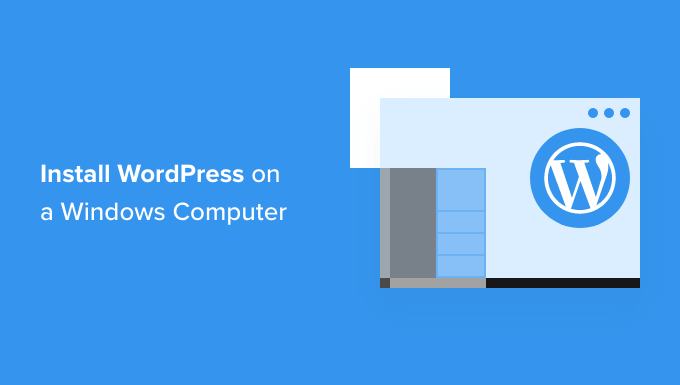
¿Por qué debería instalar WordPress en Windows?
Si eres usuario de Windows, instalar WordPress localmente en tu ordenador te ofrece varias ventajas.
Una instalación local de WordPress crea un entorno de pruebas que no afecta a su sitio web. Esta configuración, a menudo llamada servidor local o localhost, es tu patio de recreo personal para WordPress.
Los desarrolladores de WordPress utilizan habitualmente instalaciones locales para su trabajo. Por ejemplo, pueden utilizarla para experimentar con nuevos plugins o temas o probar el sitio antes de actualizarlo al editor de bloques Gutenberg.
Pero no es sólo para los profesionales. Si eres nuevo en WordPress, una configuración local es perfecta para aprender. Puedes explorar funciones, probar temas y plugins, y experimentar libremente sin preocuparte de romper un sitio activo.
Es importante tener en cuenta que cuando instalas WordPress localmente en Windows, sólo tú puedes ver el sitio. Si quieres crear un sitio web público, necesitarás un nombre de dominio y alojamiento web.
Ahora, técnicamente, puedes instalar WordPress en Windows usando XAMPP, y hemos escrito un tutorial sobre ello antes.
Dicho esto, hemos encontrado 2 formas aún más sencillas que XAMPP para configurar un entorno local de WordPress, por lo que son ideales para principiantes o usuarios que necesitan crear un sitio local rápidamente. Puedes hacer clic en el enlace de abajo para saltar al método que te interese:
Método 1: Instalar WordPress en Windows con Studio (rápido y sencillo)
Para el primer método, utilizaremos Studio. Es un software local de WordPress hecho por Automattic, la empresa que gestiona y dirige WordPress.com, que es un constructor de sitios web basado en el software de WordPress.
Hablaremos primero de este método porque es mucho más rápido y sencillo de seguir, lo que lo hace perfecto para los principiantes.
En primer lugar, tienes que abrir el sitio web Studio by WordPress.com. A continuación, haz clic en el botón “Descargar para Windows”.
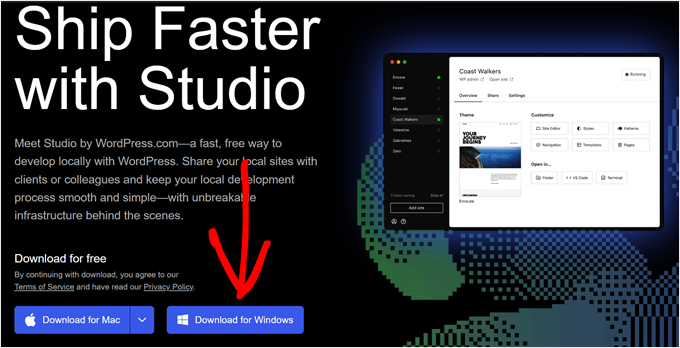
Una vez hecho esto, sólo tienes que abrir el archivo descargado para iniciar la instalación.
Aparecerá una ventana emergente que le indicará que se está instalando la aplicación.
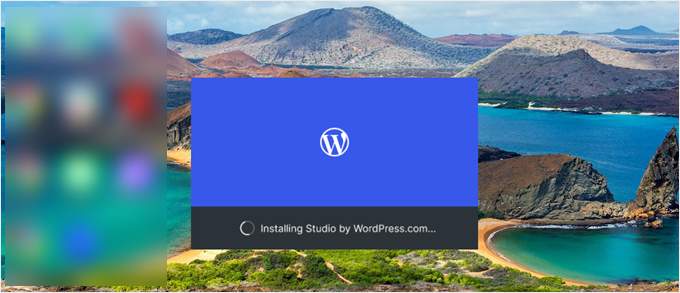
Una vez hecho esto, puede añadir su primer sitio.
Para ello, introduce el nombre de tu nuevo sitio local de WordPress y haz clic en “Añadir sitio”. Puedes nombrar el sitio como quieras siempre que te ayude a identificarlo fácilmente.
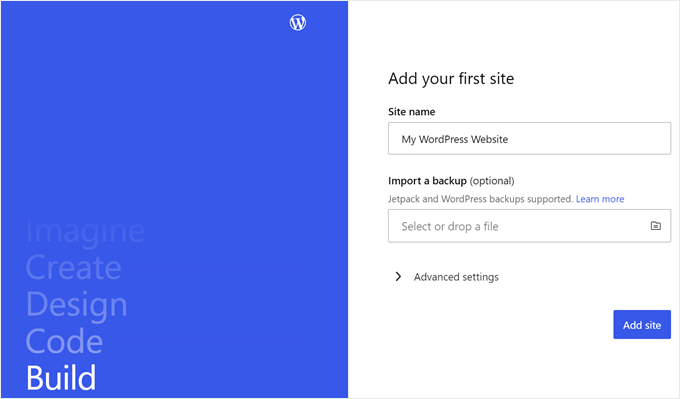
Ahora debería ver el escritorio de WordPress local.
Para acceder a tu escritorio de WordPress y editar tu sitio web, sólo tienes que hacer clic en el botón “Inicio” situado en la esquina superior derecha. De este modo, podrá acceder a su sitio web local desde su ordenador.
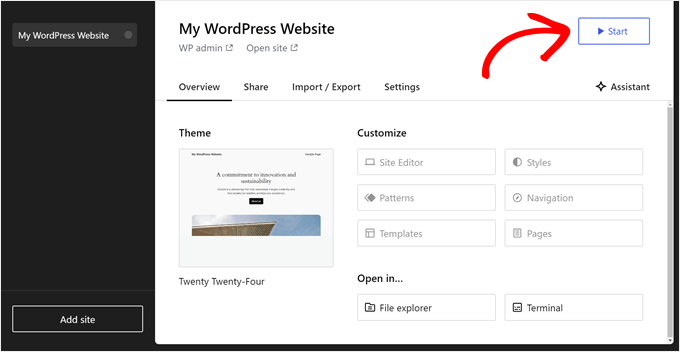
Una vez que el botón “Iniciar” cambie a “Ejecutando”, puede hacer clic en el enlace “WP Admin” en la parte superior izquierda de la página.
Esto le llevará a su página local de administración de WordPress.
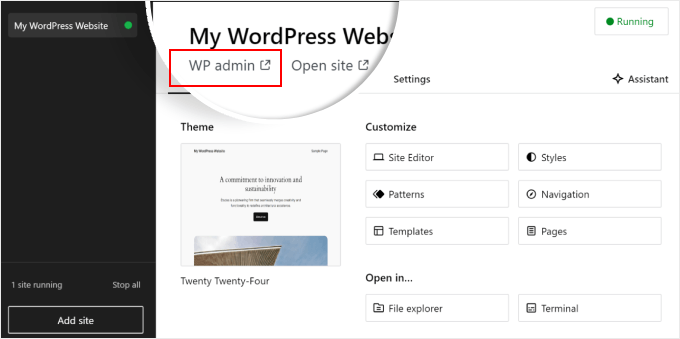
Y eso es más o menos todo para la configuración. Vamos a explorar los otros ajustes que pueden ser necesarios a medida que construye su sitio web local.
Como puedes ver en la pestaña ‘Visión general’, puedes acceder inmediatamente al menú completo del editor de WordPress directamente desde el escritorio de Studio. También puedes hacer clic en “Explorador de archivos” para abrir las carpetas y archivos de tu sitio web de WordPress y hacer clic en “Terminal” para administrar tu sitio web mediante WP-CLI.
Si cambias a la pestaña “Compartir”, puedes acceder a tu cuenta de WordPress.com, clonar tu sitio web local y subirlo a los servidores de WordPress.com. Esto hará que el sitio clonado esté online temporalmente, lo que resulta útil para compartir sitios de demostración con tus clientes o miembros del equipo.
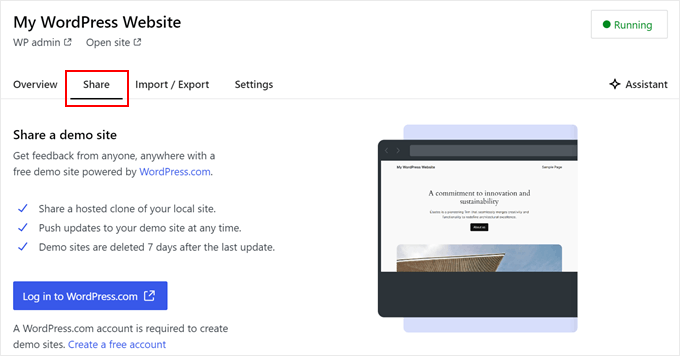
A veces, es posible que desee iniciar sesión en su sitio web local directamente a través de su navegador en lugar de utilizar Studio. En ese caso, necesita conocer sus credenciales de wp-admin.
Para encontrarlos, puede cambiar a la pestaña “Configuración” y encontrar allí su nombre de usuario, contraseña y URL de inicio de sesión de administrador de WordPress.
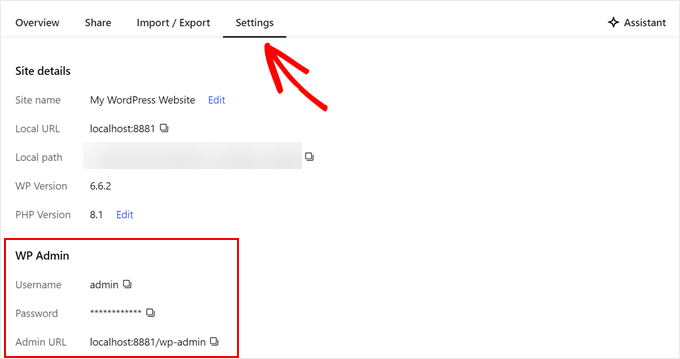
Otra característica interesante de Studio es su chatbot de inteligencia artificial integrado, con el que puedes comunicarte pulsando el botón “Asistente”.
Aquí puedes pedir ayuda a Studio para tareas como actualizar todos tus plugins a la vez, actualizar la versión principal de WordPress o crear código para un bloque personalizado.
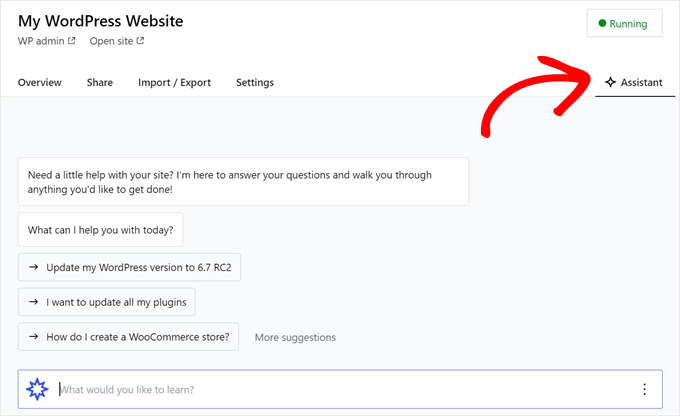
Cuando hayas terminado de trabajar en tu sitio local, sólo tienes que pasar el ratón por encima del botón “En ejecución” de la esquina superior derecha hasta que ponga “Detener”.
A continuación, haga clic en el botón para detener el sitio web.
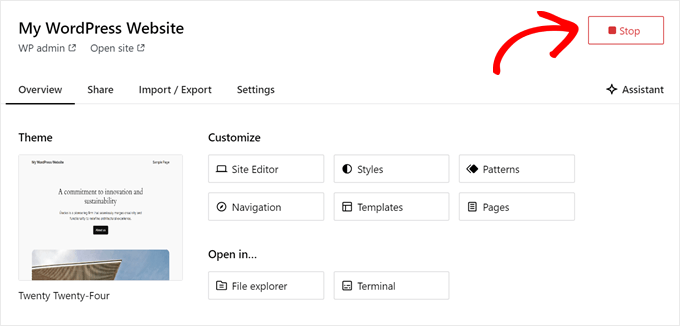
Una desventaja de Studio es que no puedes configurar el entorno de WordPress a tu gusto. Esto significa que tienes que utilizar la versión de PHP, el servidor web y la base de datos que se han preseleccionado para ti.
Esto puede ser un inconveniente si necesitas probar tu sitio web o plugin con configuraciones de servidor específicas.
Si necesita un mayor control sobre su entorno local de WordPress o necesita que su configuración local coincida con una configuración específica del servidor en vivo, entonces puede consultar el siguiente método usando WP Local.
Método 2: Instalar WordPress en Windows Usando WP Local (Más Personalizable)
En primer lugar, debe descargar e instalar el software Local WP en su ordenador Windows. Simplemente vaya al sitio web de Local WP y haga clic en el botón “Descargar gratis”.
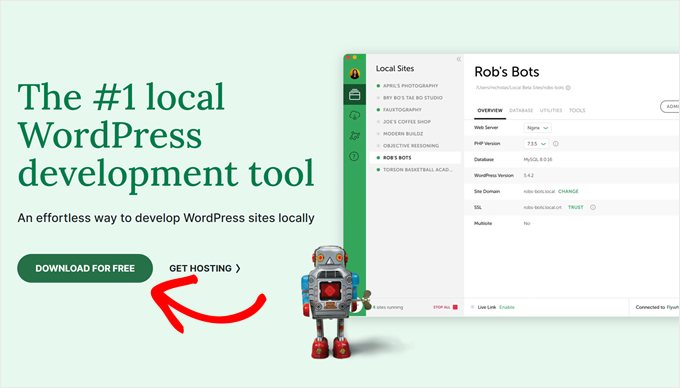
A continuación, aparecerá una ventana emergente en la que tendrás que seleccionar tu plataforma. Elige “Windows” en el menú desplegable.
A continuación, puedes introducir tus datos, como nombre y apellidos, dirección de correo electrónico laboral y número de teléfono, para descargar el software.
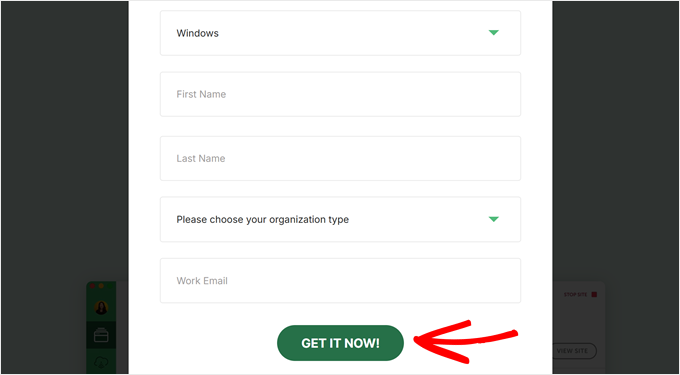
Una vez introducidos los datos, basta con hacer clic en el botón “Consíguelo ahora”.
A continuación, el software se descargará automáticamente en tu ordenador. De lo contrario, puede hacer clic en el enlace “haga clic aquí” para iniciar la descarga.
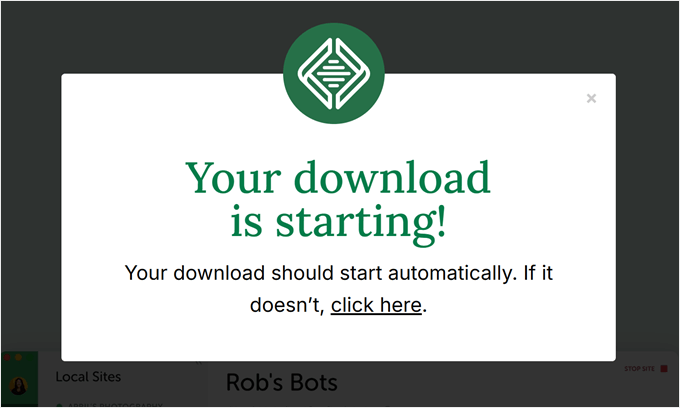
Una vez descargado el archivo, inicie el asistente de instalación.
Ahora, tendrás que seleccionar si quieres instalar el software para todos los usuarios o sólo para ti.
Una vez seleccionada una opción, pulse el botón “Siguiente”.
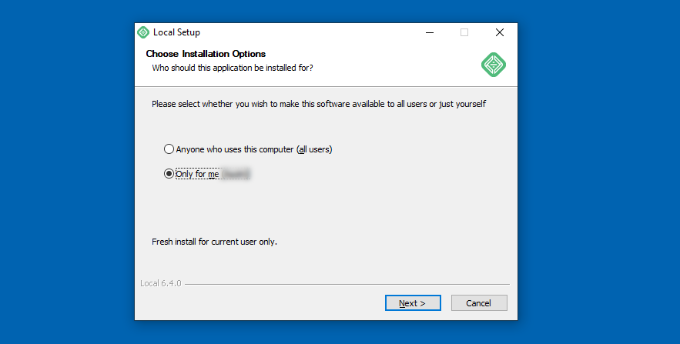
En el siguiente paso, puede seleccionar la “Carpeta de destino” donde se instalará el software.
Basta con hacer clic en el botón “Examinar” para establecer la ruta y, a continuación, hacer clic en el botón “Instalar”.
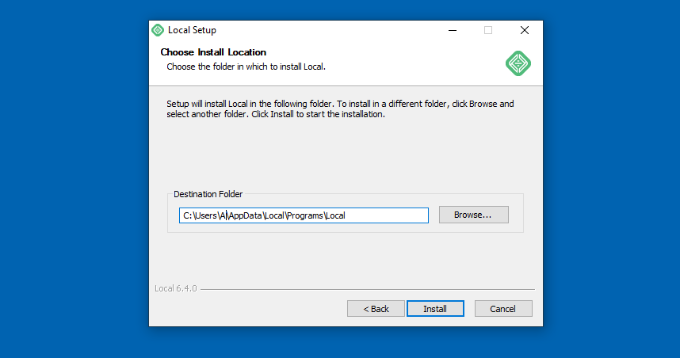
El software Local WP se instalará en tu ordenador Windows.
Una vez hecho esto, puede marcar / comprobar la casilla de verificación “Ejecutar localmente” y hacer clic en el botón “Finalizar” del asistente de configuración.
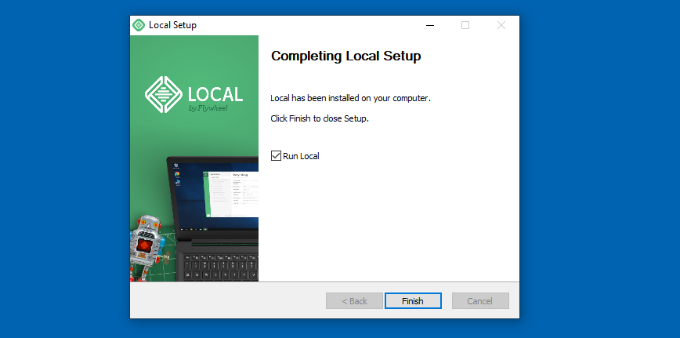
El software se iniciará ahora en su dispositivo Windows.
El siguiente paso es añadir un nuevo sitio web local. Para ello, basta con hacer clic en el botón “+” de la parte inferior.
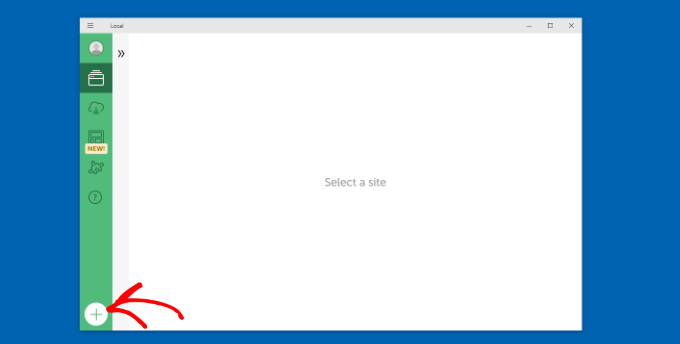
Después, puede crear un sitio en el software Local.
Seleccione la opción “Crear un nuevo sitio” y haga clic en el botón “Continuar”. También hay opciones para crear el sitio desde un plano o un archivo de sitio web existente, pero vamos a ir con la primera opción en aras de la demostración.
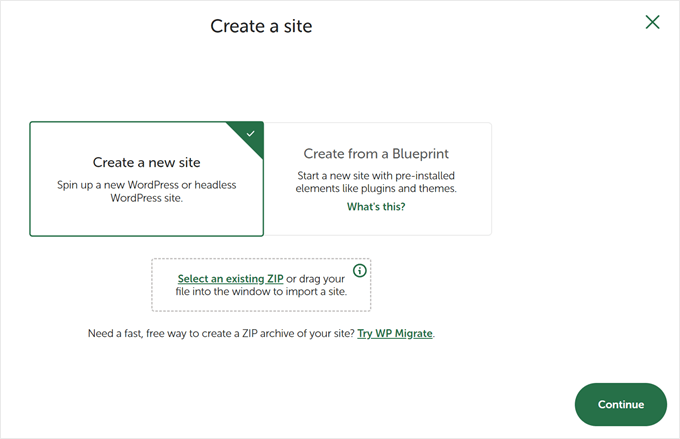
A continuación, puede introducir un nombre para su sitio web local, como “Mi sitio web WordPress”.
También hay opciones avanzadas en las que puede introducir el dominio del sitio local y la ruta del sitio local. Por defecto, el dominio utilizará el título de su sitio web, pero separado por guiones.
Una vez que haya terminado, simplemente haga clic en el botón “Continuar”.
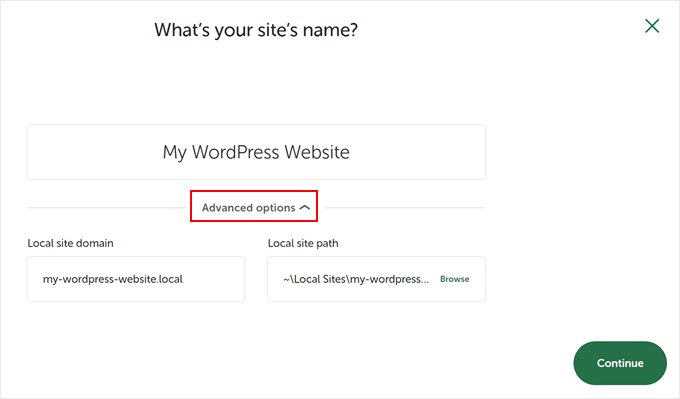
Después, tendrá que elegir un entorno para su sitio web local.
Puede utilizar el entorno ‘Preferido’, en el que el software seleccionará automáticamente la versión de PHP, el servidor web y la versión de MySQL. Por otro lado, también puedes seleccionar ‘Personalizado’ e introducir los detalles del entorno.
Local WP ofrece las últimas versiones de PHP. En cuanto al servidor web, puedes elegir entre Nginx o Apache. También puedes seleccionar entre MySQL o MariaDB para las bases de datos.
Tenga en cuenta que algunas versiones de PHP, servidores web y bases de datos requieren la descarga de algunas dependencias para que funcionen correctamente.
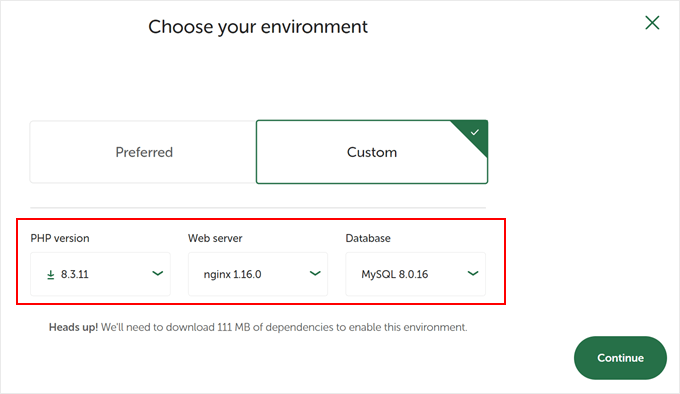
A continuación, puedes introducir un nombre de usuario y una contraseña de WordPress para tu sitio web local. Además, también tienes la opción de elegir una dirección de correo electrónico de WordPress en la que recibirás todas las notificaciones por correo electrónico.
Aparte de eso, hay una opción avanzada en la que el programa te preguntará si tienes una red multisitio de WordPress. Si no es así, haz clic en “No”.
Tras introducir estos datos, basta con hacer clic en el botón “Añadir sitio”.
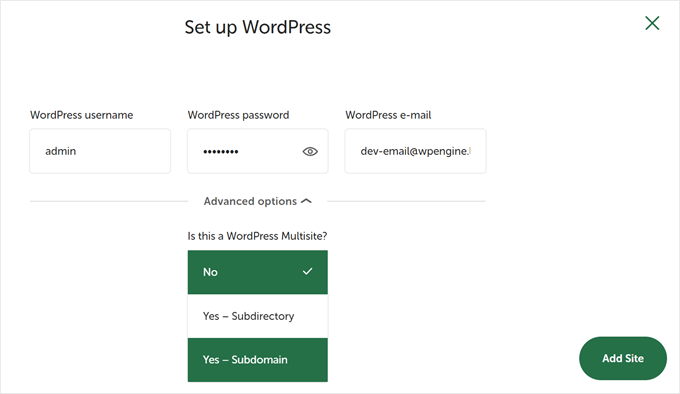
El programa instalará WordPress y establecerá su sitio web.
Para iniciar el sitio web local, haz clic en el botón “Iniciar sitio” situado en la esquina superior derecha.
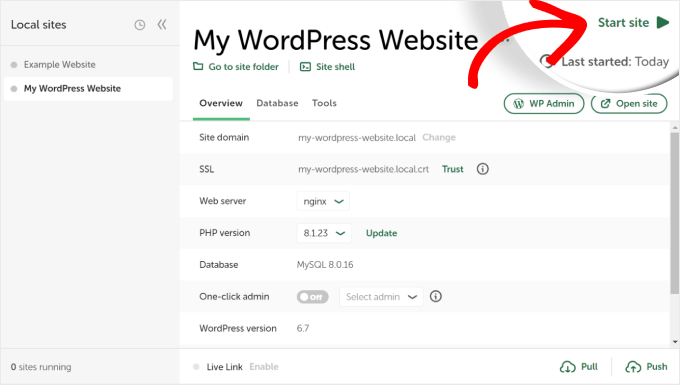
A continuación, haz clic en el botón “WP Admin” y verás la página de inicio de sesión del administrador de WordPress.
Sólo tiene que introducir el nombre de usuario y la contraseña que introdujo anteriormente al configurar el sitio web local y, a continuación, hacer clic en el botón “Iniciar sesión”.
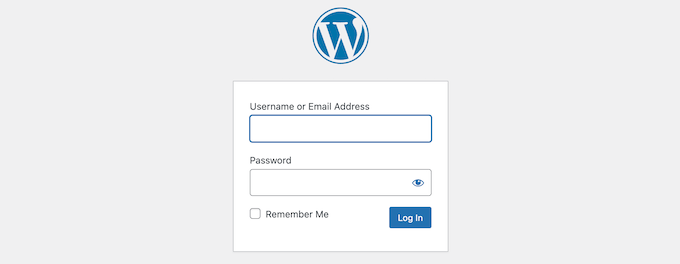
Ahora puede editar su sitio web local en su ordenador Windows.
Cuando haya terminado, no olvide detener el sitio web desde el software WP local al hacer clic en el botón “Detener sitio”.
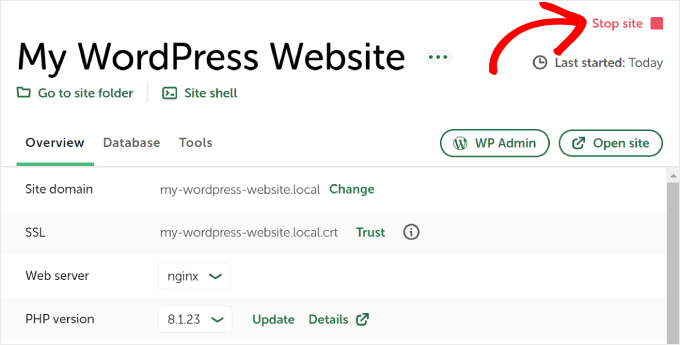
Consejo profesional: Si desea omitir el proceso de inicio de sesión, puede habilitar un inicio de sesión de administrador con un solo clic en Local WP.
Para ello, vuelve al panel de control de Local WP y activa el botón “One-click admin” hasta que aparezca “On”. A continuación, en el menú desplegable, seleccione el usuario administrador que puede utilizar esta función de inicio de sesión con un solo clic.
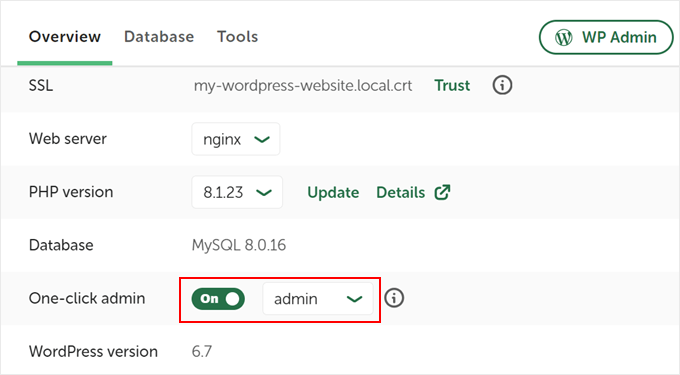
Alternativa: Utiliza WordPress Playground para probar temas, plugins y mucho más
WordPress Playground es una herramienta innovadora que te permite experimentar con WordPress directamente en tu navegador web. Es una caja de arena virtual donde puedes probar nuevos temas, plugins y funciones de WordPress sin afectar a ningún sitio web real.
WordPress Playground difiere de un entorno local de WordPress en varios aspectos clave.
En primer lugar, no requiere instalación en tu ordenador y se reinicia después de cada uso, a diferencia de las instalaciones locales permanentes. Puedes acceder a ella desde cualquier dispositivo con un navegador, mientras que las instalaciones locales están atadas a un ordenador.
Mientras que WordPress Playground es ideal para pruebas rápidas y aprendizaje, un entorno local de WordPress en su ordenador Windows ofrece más flexibilidad para proyectos de desarrollo a largo plazo.
Para obtener información detallada, consulte nuestra guía sobre cómo utilizar WordPress Playground en su navegador.
He instalado WordPress en mi ordenador Windows, ¿y ahora qué?
Ahora que ya tienes WordPress en tu ordenador, aquí tienes algunas cosas que puedes hacer:
- Aprenda trucos y consejos básicos de WordPress para utilizar mejor su sitio.
- Pruebe diferentes temas de WordPress para ver cómo puede quedar su sitio.
- Instale y pruebe los plugins imprescindibles de WordPress para añadir nuevas funciones a su sitio.
- Aprenda a solucionar errores comunes de WordPress por su cuenta.
- Pruebe diferentes creadores de páginas de arrastrar y soltar para que su sitio tenga un aspecto atractivo.
- Aprenda a restablecer la contraseña de administrador de WordPress en localhost para recuperar el acceso a su sitio.
- Establezca flujos de trabajo automatizados para facilitar la gestión de su sitio.
- Infórmese sobre la seguridad de WordPress para mantener su sitio a salvo de los piratas informáticos.
- Traslade su sitio local de WordPress a un servidor activo cuando esté listo para compartirlo con todo el mundo.
Esperamos que este artículo te haya ayudado a aprender cómo instalar WordPress localmente en un ordenador con Windows. Puede que también quieras ver nuestro artículo sobre cómo instalar WordPress localmente en un ordenador Mac y nuestra guía definitiva para crear un sitio de prueba de WordPress.
If you liked this article, then please subscribe to our YouTube Channel for WordPress video tutorials. You can also find us on Twitter and Facebook.




Francesco
Hi,
Can I use this system to test a previous back up I did via the server control panel?
I have a zip file which is a mirror of my directory on the server, including database and WP-admin file.
I would line to test if the backup I have works fine and possible run it on a precioys version of the WP
WPBeginner Support
You would want to check with the tool you are using for the specifics but it should allow you to do what you’re wanting.
Admin
Melissa T
Installed WAMP and WordPress – thanks for the wonderfully detailed instructions! So now it’s time to create the web site — is there a guide on wpbeginner for that?
thank you!
WPBeginner Support
There are many different types of sites so there is no complete guide but for a starting point you may want to take a look at our article below. Step 3 and beyond in the guide should help.
https://www.wpbeginner.com/guides/
Admin
kwestyon
First, thank you so much for the guide! It’s working. Second, is there a way wherein after you create the website, would there a way to view the site after you clicked the published button. Sorry for the dumb question.
WPBeginner Support
If you are logged in, in the top right you should be able to open the dropdown that has your site title, and there you should find a link to view your site.
Admin
Yomi
Hello,
If I install WordPress on a localhost based on the content of this blog, will I be able to use plugins like woocommerce, elementor, astra & kadence?
Thank you.
WPBeginner Support
Yes, installing locally you would be able to use plugins and page builders like those on your site
Admin
Lisa
Hi,
I am at the point where I would put localhost/mysite/ in the browser. I am getting the “404 not found error”.
I named the copy of wordpress to wamp the same and have double checked the address to see if it’s typed in correctly. This still happens, what am I doing wrong?
Thanks!
WPBeginner Support
You would want to ensure you’re not running into the Skype error where it is trying to use port 80 while WAMP is.
Admin
WPBeginner Support
Currently, the WAMP website is down which is why we’ve added a different link and included a note above and are working on updating this article as quickly as we are able
Admin
mark
WAMP link redirects to a different site.
Faten
Hi team,
I followed the guide but when I go to local host/my site/ I have this error: your don’t have permission to access my site on this server.
Can you please help?
My folders are in this order: c/wamp/www folder/mysite, is that correct?
WPBeginner Support
That is the correct location, you would want to ensure WAMP is running when you see that specific error message.
Admin
Sam
Our published website was created using an older versions of WP, themes, and plugins. I would like to test against the latest versions of WP, themes, and plugins on a local PC installation.
If I backup the website data from the live online WP account using UpdraftPLus, can I restore the files on the local installation to test against the latest versions of WP, themes, and plugins?
If not, what is the most effective method to do so?
Thank you so much!
WPBeginner Support
You can do that or you could create a staging environment here:
https://www.wpbeginner.com/wp-tutorials/how-to-create-staging-environment-for-a-wordpress-site/
Admin
Jerelyn
Hi, the WampServer link (website) has not been working the past few days. Is there an alternative place to get it? Thanks.
WPBeginner Support
Not that we would recommend at the moment, hopefully, the issues on the site at the moment are resolved and the site starts working again soon.
Admin
Harry
I am trying to do the localhost/mysite/ part but every time I search this it says url not found how do I put the WordPress folder with the WAMP folder
WPBeginner Support
You would go to where you installed WAMP on your computer, and place the mysite folder inside the www folder
Admin
Jyoti
I installed WAMP and able to see a GREEN icon in system tray.
But i am not able to see anything when i click on that icon.No PHP database nothing at all.I uninstalled and reinstalled but didn’t work.
Would you please help?
thank you so much.
WPBeginner Support
You would normally want to enter localhost in your browser while the green W is in your icon tray to find that
Admin
Pete
I installed WampServer, but it wouldn’t run. All I saw was a couple of windows with command prompts briefly appear and then disappear.
WPBeginner Support
You should see the WAMP icon if you expand your icon tray in the bottom right
Admin
HSM
it happened with me, and solved it like that:
when entering the database name, and user name,
you may forgot and left the default password as written “Password”
(as happened with me)
without change it to a private password or at least remove the word “Password” and keep the field of password blank,
WPBeginner Support
Thanks for sharing the issue you ran into should others have this issue
Admin
Tracy De
Thanks for this. I was having trouble at this point. Have reinstalled everything and couldn’t work out what I was doing wrong.
Bain Dom
Can I install WordPress plugins in this WordPress on Windows 10 environment?
WPBeginner Support
Unless the plugin specifies otherwise(mainly plugins that connect to 3rd party services), you would be able to use plugins on a local installation
Admin
Chloe
Hi, I followed this guide a few weeks ago and set up the very beginnings of a test site. I now can’t remember or work out how to get back to editing the site! It’s maddening as I can launch WAMP, go to localhost/testsite/ and view the site I made but please can someone let me know how to enter editing mode!! Many thanks
WPBeginner Support
You would want to add /wp-admin to be able to log into your local installation of WordPress to be able to start editing it again
Admin
Kathleen
Thank you!!! Exactly what I needed to develop before making a site live
WPBeginner Support
You’re welcome, glad our guide could be helpful
Admin
Kathleen
Installed Wamp with no trouble thanks to your concise directions. However, after creating my database and starting the WP install I get this message:
“We were able to connect to the database server (which means your username and password is okay) but not able to select the ericajlester database.” I have been over and over checking everything to make sure the information is correct, but WP will not connect to the database. Any suggestions would be appreciated.
Thank you for such great information and support!
WPBeginner Support
The most common reason for this would be a typo in your database name, you would want to ensure the database information and prefix are both correct compared to what you have set
Admin
Alexis
Thank you so much!
WPBeginner Support
You’re welcome
Admin
Linda
Good job is done by Wpbeginner team!!!
Have a great day!
WPBeginner Support
Thank you, hope you have a great day as well
Admin
Daniel
Developing WP plugin for a client. Wanted to create a dev environment without paying for hosting space to do it. Thanks for the quick and dirty path to get there.
WPBeginner Support
Glad our article could help
Admin
Vic Iyke
This is a real life saver, thank you for the detailed instructions, it saved my time.
WPBeginner Support
Glad our guide was helpful
Admin
Erica
Thank you for the guidance..
WPBeginner Support
You’re welcome
Admin
Harish Nemade
After doing work on WordPress from WAMP, should we click on ‘Stop all services’?
WPBeginner Support
only if you wish to turn of WAMP and your local installation
Admin
Harish Nemade
The Website of WAMP which you had mentioned is not working anymore. The download is not responding from Sourceforge.net,
WPBeginner Support
From testing, the link is page is still working on our end, you may want to ensure this isn’t due to a browser or browser addon preventing your download.
Admin
Harish Nemade
Hey, I installed WAMP in the Internet Explorer folder, but once when I checked to search for my same localhost running on Explorer appeared in Chrome. But can I also Use the same Localhost from Chrome?
WPBeginner Support
If you installed your site in the wamp folder then you should be able to visit the site at localhost on any browser on that computer
kamodh singh
localhost/phpmyadmin not opening with any browser. when trying to open there are showing an error ( This site can’t be reached – ERR_CONNECTION_RESET )
How can i fix this error plz tell me .
thanks…
WPBeginner Support
If you’ve shut down your computer since the last time you used WAMP you would want to ensure it is running before visiting localhost.
Admin
Divyanshu Garg
Thank you very much for your guidance step by step.
WPBeginner Support
You’re welcome
Admin
Nena Rahin
The code execution cannot proceed because MSVCR120.dil was not found. Reinstalling the program may fix the problem.
The code excicution cannot proceed because VCRUNTIME140.dil was not found.
Reinstalling the program may fix the problem.
I get this error even after reinstalling many times.
Please help
WPBeginner Support
You would want to download the C++ redistributable we link to in the article and that should get you past these errors.
Admin
Dean
Hi, Thank you so very much for being here! All your information etc. is truly a gift, and it’s appreciated very much!
I’ve successfully installed WAMP and WordPress on my local computer and have played around somewhat. I’d like to refresh WordPress to start fresh again. Can you point me in the direction of doing this?
Thanks much!
Dean
WPBeginner Support
You could either delete the WordPress folder and install a new WordPress site or you could reset your database using the method in our article here: https://wordpress.org/plugins/wordpress-database-reset/
Admin
Dean
Thanks so much!
WPBeginner Support
Glad we could help
Elizabeth
Great tutorial. I’ve been building sites for a long time in Dreamweaver, switched to WordPress in 2015 and am now using Divi by Elegant Themes to build my sites. I need to rebuild an existing website for a yoga studio I did in 2015 without bringing down the current site and this is just the answer! Fabulous job in explaining step-by-step how to do it. Thank you so much! I am so excited to get working on this!!!
WPBeginner Support
Glad our tutorial could help
Admin
Marama
I’ve been thinking about the blogging thing and didn’t want to go straight into a Live site. This tutorial is awesome Thank you. I have installed WordPress to a localhost and now I can put everything in my test site. So Stoked!!
WPBeginner Support
Awesome, glad our article could help you get a localhost site set up for you to test
Admin
Mike
Quick question, Which ports rely on this, so i can create firewall rules in our firewall as well as have our Server Team create them in windows? Thanks for any info.
WPBeginner Support
Sadly, there are too many programs that may or may not use the ports for us to give a list at the moment.
Admin
Thelynx
Thank you for this excellent tutorial. I have been a WP webmaster for about a year at work and finally decided to set up my own page about flight simulation. I followed the instructions to the letter and now have WP setup on my home PC ready to build the next earth shattering website. I am by no means a noobie to the net, but never dug into all this. Without your help, I’d be floundering. Thank you again. The WPverse is truly a grand community.
WPBeginner Support
You’re welcome, glad our guide could help you
Admin
Anupama
I am having an issue with my login setup it says. (see it below) even though I login in PHP server with new data still says that. what am I gonna do.?
Error establishing a database connection
This either means that the username and password information in your wp-config.php file is incorrect or we can’t contact the database server at localhost. This could mean your host’s database server is down.
Are you sure you have the correct username and password?
Are you sure that you have typed the correct hostname?
Are you sure that the database server is running?
If you’re unsure what these terms mean you should probably contact your host. If you still need help you can always visit the WordPress Support Forums.
WPBeginner Support
You would want to edit your wp-config file in a text editor and ensure your information in this file is correct. We have an article on how to edit it here: https://www.wpbeginner.com/beginners-guide/how-to-edit-wp-config-php-file-in-wordpress/
Specifically, the database name is normally where problems can happen
Admin
Mike
Thank you very much for this awesome solution. I was searching for something like that and I have seen that you have provided an additional tutorial of how to deploy the offline WP website to a web hoster. Great work THX again.
WPBeginner Support
You’re welcome, glad our guides can be helpful
Admin
Emm Man
For all who faced the issue ‘404’ when tried ‘localhost/{yourSiteName}’, one possible solution (for me at least) is to add also the port of wamp server e.g. localhost:8080/{yourSiteName}
WPBeginner Support
Thanks for sharing a possible solution
Admin
Su
I am building a website for a friend. She already has an old site which is live. I plan to build the new one locally using WAMP.
However, while working on it how do I share my progress with her? So that she can revert for any changes.
WPBeginner Support
There isn’t a simple method for allowing someone to view your local installation, you may want to check with the hosting provider to see if there is the option of a staging environment for an easier method of what you’re wanting.
Admin
Caragh
Thanks for the great step by step guide.
Just wondered if I could screen share say through skype or Zoom?
WPBeginner Support
That is one possibility it just means that the user can’t directly interact with the site.
JAcob
Hi I would like to install/ run my sample wordpress site off of an external harddrive on various machines of my choosing. Is there any special instructions for this or do I simply install WAMP as described except onto the external drive?
WPBeginner Support
It is an older article, but for what you’re wanting you would use XAMPP: https://www.wpbeginner.com/wp-tutorials/how-to-install-wordpress-on-a-usb-stick-using-xampp/
Admin
Adam Bermingham
Hi, you missed an entire step, and it’s a complicated one. All the MS C++ applications. I don’t know what to download or where to save them. Very confusing. There must be an easier way to host a demo WordPress site than this??
WPBeginner Support
Thanks for letting us know, we will certainly look to include that information when we update this article. For the time being, you should be able to go to the WAMP forums and the specific files should be linked and you would only need to install them where they automatically set their installations
Admin
Duncan McCormack
You don’t need all of them, just the ones shown in the WAMPserver page when you click either download (it’s the second “warning” – yes, it’s in French) – just get the 64/32bit versisons of those.
Richard
hi, first of all thanks for the amazing tutorials!
i have a question – I want to create my first website with wordpress. i thought about using wamp to save the money of the domain use and hosting and then move the website to the domain after it is done.
do you think that’s a good idea? will it be a problem to move the website from the local server to the live site as described it this tutorial? –
https://www.wpbeginner.com/wp-tutorials/how-to-move-wordpress-from-local-server-to-live-site/
WPBeginner Support
You could certainly create your site locally and then follow the steps in that article to move your site and you shouldn’t run into any problems.
Admin
Sakil Ahmed
I uninstalled Skype and installed visual C++ but after installing WAMP Server app, clicking the wamp icon in the system tray doesn’t effects and the pop-up to create a database from myphpadmin doesn’t open.
WPBeginner Support
You may want to check the Skype conflict we mention in the article and should that not be the issue, reach out to WAMP’s support to see if there is a possible known issue.
Admin
Deepti
Hi
I am planning to make a website of my own . Its basically a food blog. I ahve a good knowledge of programming. However, I have a gap of around 7 yrs and really dont know the new stuff in programming like bootstrap, etc..I am still in learning phase for these concepts.
Would u suggest me to make a website using wordpress.org or wordpress.com?
WPBeginner Support
We would normally recommend a WordPress.org site, you can see our comparison here: https://www.wpbeginner.com/beginners-guide/self-hosted-wordpress-org-vs-free-wordpress-com-infograph/
Admin
Jem
Hi there,
I am building wordpress.com site as the client didn’t want to manage hosting separately. I have only ever used wordpress.org. Can you still design the site on a local server and upload in when completed onto a wordpress.com site? I am a little unsure of the limitations of the .com version.
Thanks so much
WPBeginner Support
You would not be able to upload a new site on WordPress.com, you would normally need to build the site from the beginning on WordPress.com due to their restrictions.
Admin
Seema
Hi,
This is a great tutorial.
I am stuck with “Error establishing a database connection” error since a day. For me WAMP works fine, I created a DB then unzip the WP. After localhost/mysite it goes till language selection page get the DB details and when i submit it gives above mentioned error. Tried putting DB details in wp-config-samle.php, same error. Deleted DB created again, deleted mysite folder created again but still same error. Can somebody please help?
WPBeginner Support
For that error on localhost you may want to ensure you have all of your database information set properly. The database information is normally root with a blank password or you could add a space if it is preventing you from leaving it blank unless you changed that login information.
Admin
Onur SANIR
Hey I found the solution.
Left Click Wamp Icon > Mysql x.x.x > Use port other than 3xxx > Press Ok
Bobby
Any way to take a copy of my live hosted site from iPage and put a copy on the WAMP for testing with plugins, etc?
If so how would I do that?
WPBeginner Support
You would want to take a look at our guide on how to do that here: https://www.wpbeginner.com/wp-tutorials/how-to-move-live-wordpress-site-to-local-server/
Admin
Hang
Thank you so much <3
WPBeginner Support
You’re welcome
Admin
Jason
Worked awesome. Thank you.
WPBeginner Support
Glad our guide helped
Admin
Barbara
Wow! So straightforward! Thank you!
WPBeginner Support
Glad our article was helpful
Admin
Henrik
Hi, first of all thanks for a very helpful post. Secondly, a question: will having multiple wordpress installations in a single database affect the migration to a live environment when the time comes? Or should I just deploy a new database to be on the safe side? cheers
WPBeginner Support
You would want to use a database for each site to make transferring environments easier.
Admin
Joe
Thanks so much. Very well written installation guide. Installed without a single glitch.
WPBeginner Support
Glad our guide could help you
Admin